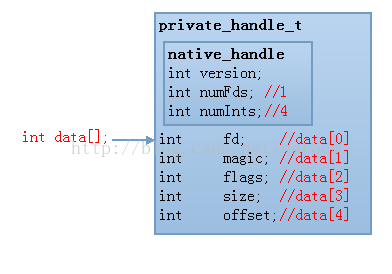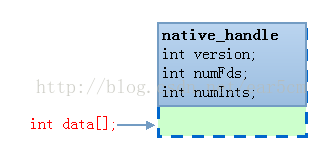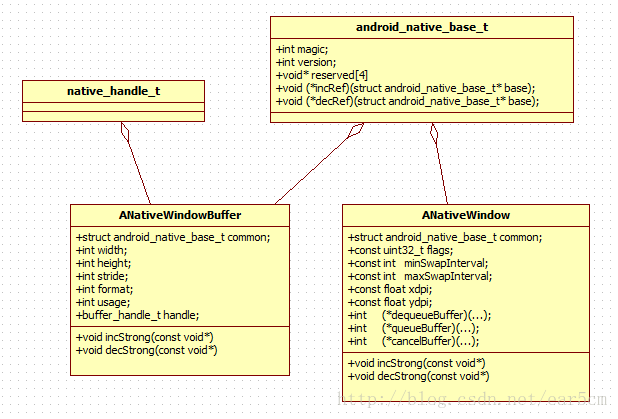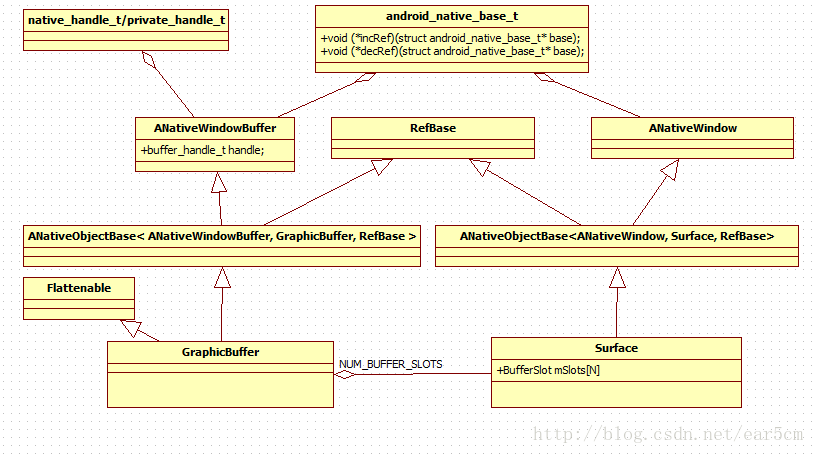Android中native_handle private_handle_t ANativeWindowBuffer ANativeWindow GraphicBuffer Surface的关系
在阅读SurfaceFlinger HardwareComposer以及gralloc相关代码的过程中,我们经常会遇到native_handle private_handle_t ANativeWindowBuffer ANativeWindow GraphicBuffer Surface等等一系列和memory相关的struct和class,他们相互之间到底是什么区别,又有什么联系呢?本文从struct/class的结构角度分析下上述类型之间的关联.
概括来说,native_handle private_handle_t ANativeWindowBuffer GraphicBuffer这四个struct/class所描述的是一块memory,而ANativeWindow 和Surface所描述的是一系列上述memeory的组合和对buffer的操作方法.有的struct/class在比较低的level使用,和平台相关,而另外一些在比较高的level使用,和平台无关,还有一些介于低/高level之间,用以消除平台相关性,让android可以方便的运行在不同的平台上.
我们依次来看下上述struct/class的定义:
1. native_handle
system/core/include/cutils/native_handle.h
typedef struct native_handle
{
int version; /* sizeof(native_handle_t) */
int numFds; /* number of file-descriptors at &data[0] */
int numInts; /* number of ints at &data[numFds] */
int data[0]; /* numFds + numInts ints */
} native_handle_t;native_handle/native_handle_t只是定义了一个描述buffer的结构体原型,这个原型是和平台无关的,方便buffer在各个进程之间传递,注意成员data是一个大小为0的数组,这意味着data指向紧挨着numInts后面的一个地址.我们可以把native_handle_t看成是一个纯虚的基类.
一般来说,我们描述一块buffer,需要知道它在kernel中对应的fd,虚拟地址/物理地址,offset,size等等信息,后面我们在private_handle_t中就可以看到这些字段.android的gralloc模块负责从fb设备或者gpu中分配meomory,所以我们在gralloc中就可以找到native_handle的具体实现,gralloc中对buffer的描述就和具体的平台相关了,我们以aosp中最基本的gralloc为例,来看下gralloc中对native_handle是如何使用的.
2.private_handle_t
hardware/libhardware/modules/gralloc/gralloc_priv.h
#ifdef __cplusplus
//在c++编译环境下private_handle_t继承于native_handle
struct private_handle_t : public native_handle {
#else
//在c编译环境下,private_handle_t的第一个成员是native_handle类型,其实和c++的继承是一个意思,
//总之就是一个指向private_handle_t的指针同样也可以表示一个指向native_handle的指针.
struct private_handle_t {
struct native_handle nativeHandle;
#endif
// file-descriptors
int fd;
// ints
int magic;
int flags;
int size;
int offset;
// 因为native_handle的data成员是一个大小为0的数组,所以data[0]其实就是指向了fd,data[1]指向magic,以此类推.
// 上面提到我们可以把native_handle看成是一个纯虚的基类,那么在private_handle_t这个派生类中,numFds=1 numInts=4.
...
}
3. buffer_handle_t
标题中并没有提到这个类型,因为这个类型实在是太简单了,我们看code
system/core/include/system/window.h
typedef const native_handle_t* buffer_handle_t;sturct native_handle
native_handle_t
struct private_handle_t
这三个类型可以看作是同一个东西,而buffer_handle_t则是指向他们的指针.
那么android是如何使用这些struct的,gralloc分配的buffer如何和android联系起来呢?
我们继续来看window.h
4. ANativeWindowBuffer和ANativeWindow
在具体分析ANativeWindowBuffer和ANativeWindow之前,我们先来看下和这两个类型都相关的另外一个结构体android_native_base_t
system/core/include/system/window.h
typedef struct android_native_base_t
{
/* a magic value defined by the actual EGL native type */
int magic;
/* the sizeof() of the actual EGL native type */
int version;
void* reserved[4];
/* reference-counting interface */
void (*incRef)(struct android_native_base_t* base);
void (*decRef)(struct android_native_base_t* base);
} android_native_base_t;typedef struct ANativeWindowBuffer
{
#ifdef __cplusplus
ANativeWindowBuffer() {
// ANDROID_NATIVE_BUFFER_MAGIC的值是"_bfr"
common.magic = ANDROID_NATIVE_BUFFER_MAGIC;
common.version = sizeof(ANativeWindowBuffer);
memset(common.reserved, 0, sizeof(common.reserved));
}
// Implement the methods that sp expects so that it
// can be used to automatically refcount ANativeWindowBuffer's.
// 调用common,也就是android_native_base_t的incRef和decRef函数,具体函数是什么还不知道
void incStrong(const void* /*id*/) const {
common.incRef(const_cast(&common));
}
void decStrong(const void* /*id*/) const {
common.decRef(const_cast(&common));
}
#endif
// common的incRef和decRef还没有明确是什么
struct android_native_base_t common;
int width;
int height;
int stride;
int format;
int usage;
void* reserved[2];
// buffer_handle_t是指向sturct native_handle, native_handle_t, struct private_handle_t的指针.
buffer_handle_t handle;
void* reserved_proc[8];
} ANativeWindowBuffer_t;
// Old typedef for backwards compatibility.
typedef ANativeWindowBuffer_t android_native_buffer_t; struct ANativeWindow
{
#ifdef __cplusplus
ANativeWindow()
: flags(0), minSwapInterval(0), maxSwapInterval(0), xdpi(0), ydpi(0)
{
// ANDROID_NATIVE_WINDOW_MAGIC的值是"_wnd"
common.magic = ANDROID_NATIVE_WINDOW_MAGIC;
common.version = sizeof(ANativeWindow);
memset(common.reserved, 0, sizeof(common.reserved));
}
/* Implement the methods that sp expects so that it
can be used to automatically refcount ANativeWindow's. */
// 调用common,也就是android_native_base_t的incRef和decRef函数,具体函数是什么还不知道
void incStrong(const void* /*id*/) const {
common.incRef(const_cast(&common));
}
void decStrong(const void* /*id*/) const {
common.decRef(const_cast(&common));
}
#endif
// common的incRef和decRef还没有明确是什么
struct android_native_base_t common;
...
int (*dequeueBuffer)(struct ANativeWindow* window,
struct ANativeWindowBuffer** buffer, int* fenceFd);
int (*queueBuffer)(struct ANativeWindow* window,
struct ANativeWindowBuffer* buffer, int fenceFd);
int (*cancelBuffer)(struct ANativeWindow* window,
struct ANativeWindowBuffer* buffer, int fenceFd);
};
/* Backwards compatibility: use ANativeWindow (struct ANativeWindow in C).
* android_native_window_t is deprecated.
*/
typedef struct ANativeWindow ANativeWindow;
typedef struct ANativeWindow android_native_window_t __deprecated; ANativeWindowBuffer和ANativeWindow还是没有给android_native_base_t的incRef和decRef指针赋值,ANativeWindowBuffer和ANativeWindow两个还是可以理解为抽象类!
5. GraphicBuffer和Surface
frameworks/native/include/ui/GraphicBuffer.h
class GraphicBuffer
: public ANativeObjectBase< ANativeWindowBuffer, GraphicBuffer, RefBase >,
public Flattenable
{
...
} frameworks/native/include/ui/ANativeObjectBase.h
// NATIVE_TYPE=ANativeWindowBuffer TYPE=GraphicBuffer REF=RefBase
template
// ANativeObjectBase多重继承于ANativeWindowBuffer和RefBase
class ANativeObjectBase : public NATIVE_TYPE, public REF
{
public:
// Disambiguate between the incStrong in REF and NATIVE_TYPE
// incStrong和decStrong直接调用其中一个基类RefBase的对应函数
void incStrong(const void* id) const {
REF::incStrong(id);
}
void decStrong(const void* id) const {
REF::decStrong(id);
}
protected:
// 给ANativeObjectBase取了个别名BASE
typedef ANativeObjectBase BASE;
ANativeObjectBase() : NATIVE_TYPE(), REF() {
// 构造函数中给ANativeWindowBuffer.common的两个函数指针赋值了!这两个指针就是我们之前在分析ANativeWindowBuffer的时候悬而未决的地方.
// incRef和decRef指针分别指向内部函数incRef和decRef
NATIVE_TYPE::common.incRef = incRef;
NATIVE_TYPE::common.decRef = decRef;
}
static inline TYPE* getSelf(NATIVE_TYPE* self) {
return static_cast(self);
}
static inline TYPE const* getSelf(NATIVE_TYPE const* self) {
return static_cast(self);
}
static inline TYPE* getSelf(android_native_base_t* base) {
return getSelf(reinterpret_cast(base));
}
static inline TYPE const * getSelf(android_native_base_t const* base) {
return getSelf(reinterpret_cast(base));
}
// 内部函数incRef和decRef调用上面的incStong和decStrong,也就是说ANativeWindowBuffer.common的两个函数指针最终会调用到RefBase的incStrong和decStrong.
static void incRef(android_native_base_t* base) {
ANativeObjectBase* self = getSelf(base);
self->incStrong(self);
}
static void decRef(android_native_base_t* base) {
ANativeObjectBase* self = getSelf(base);
self->decStrong(self);
}
}; frameworks/native/include/gui/Surface.h
class Surface
: public ANativeObjectBase
{
enum { NUM_BUFFER_SLOTS = BufferQueue::NUM_BUFFER_SLOTS };
...
struct BufferSlot {
sp buffer;
Region dirtyRegion;
};
// mSlots stores the buffers that have been allocated for each buffer slot.
// It is initialized to null pointers, and gets filled in with the result of
// IGraphicBufferProducer::requestBuffer when the client dequeues a buffer from a
// slot that has not yet been used. The buffer allocated to a slot will also
// be replaced if the requested buffer usage or geometry differs from that
// of the buffer allocated to a slot.
BufferSlot mSlots[NUM_BUFFER_SLOTS];
...
} Surface和GraphicBuffer都继承自模版类ANativeObjectBase,他使用的三个模版是ANativeWindow, Surface, RefBase,关于incRef和decRef两个函数指针的指向问题和上面GraphicBuffer是完全相同的, 这里就不赘述了.我们需要注意的是Surface有一个BufferSlot类型的成员数组mSlots,BufferSlot是GraphicBuffer的包装,所以我们可以理解为每个Surface中都有一个大小为NUM_BUFFER_SLOTS的GraphicBuffer数组.
因为Surface继承自ANativeWindow,所以Surface需要实现ANativeWindow中定义的一些接口,这些实现在Surface的构造函数中:frameworks/native/libs/gui/Surface.cpp
Surface::Surface(
const sp& bufferProducer,
bool controlledByApp)
: mGraphicBufferProducer(bufferProducer)
{
// Initialize the ANativeWindow function pointers.
ANativeWindow::setSwapInterval = hook_setSwapInterval;
ANativeWindow::dequeueBuffer = hook_dequeueBuffer;
ANativeWindow::cancelBuffer = hook_cancelBuffer;
ANativeWindow::queueBuffer = hook_queueBuffer;
ANativeWindow::query = hook_query;
ANativeWindow::perform = hook_perform;
ANativeWindow::dequeueBuffer_DEPRECATED = hook_dequeueBuffer_DEPRECATED;
ANativeWindow::cancelBuffer_DEPRECATED = hook_cancelBuffer_DEPRECATED;
ANativeWindow::lockBuffer_DEPRECATED = hook_lockBuffer_DEPRECATED;
ANativeWindow::queueBuffer_DEPRECATED = hook_queueBuffer_DEPRECATED;
const_cast(ANativeWindow::minSwapInterval) = 0;
const_cast(ANativeWindow::maxSwapInterval) = 1;
} frameworks/native/opengl/libs/EGL/eglApi.cpp
EGLSurface eglCreateWindowSurface( EGLDisplay dpy, EGLConfig config,
NativeWindowType window,
const EGLint *attrib_list)
{
...
}frameworks/native/opengl/include/EGL/eglplatform.h
typedef struct ANativeWindow* EGLNativeWindowType;
typedef EGLNativeWindowType NativeWindowType;总结一下,
native_handle/native_handle_t是private_handle_t的抽象表示方法,消除平台相关性,方便private_handle_t所表示的memory信息在android各个层次之间传递.而buffer_handle_t是指向他们的指针.
ANativeWindowBuffer将buffer_handle_t进行了包装,ANativeWindow和ANativeWindowBuffer都继承于android_native_base_t,定义了common.incRef和common.decRef两个函数指针,但是并没有为函数指针赋值,所以ANativeWindow和ANativeWindowBuffer仍然是抽象类.
GraphicBuffer和Surface通过继承模版类ANativeObjectBase并指定其中一个模版是RefBase,为incRef和decRef两个指针分别赋值为RefBase的incStrong和decStrong,这样
GraphicBuffer继承了ANativeWindowBuffer,Surface继承了ANativeWindow,并且两者都具有的和RefBase同样的incStong decStrong成员函数.
Surface的成员BufferSlot mSlots[NUM_BUFFER_SLOTS];可以看作是sp
关于ANativeWindow的使用方法,我们可以在SurfaceFlinger中找到一个很好的列子,就是SF的captureScreen接口,我们下一篇文章继续讨论.


